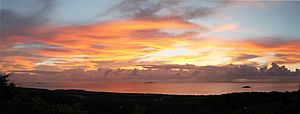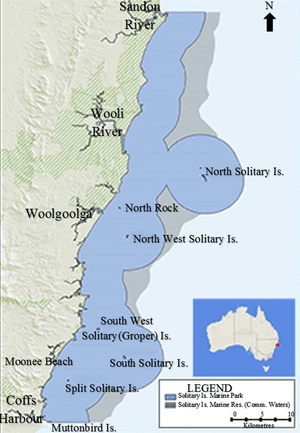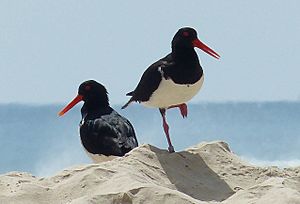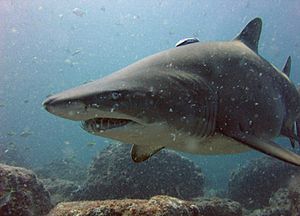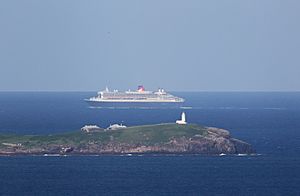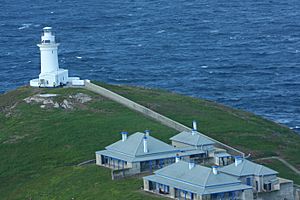Solitary Islands Marine Park facts for kids
The Solitary Islands Marine Park (often called SIMP) is a special ocean area in New South Wales, Australia. It's like an underwater national park! It was created in January 1998 to protect the amazing marine life found here.
This park stretches along the northern NSW coast for about 75 kilometres. It goes from Muttonbird Island in Coffs Harbour all the way to Plover Island near the Sandon River. The park includes coastal rivers, lakes, and extends three nautical miles out into the sea. It covers a huge area of about 72,000 hectares.
There are five main islands in the park: North Solitary Island, North West Solitary Island, South West Solitary Island (also known as Groper Island), South Solitary Island, and Split Solitary Island. Other important spots include Muttonbird Island and hidden reefs under the water.
Did you know that Lieut. James Cook sailed past these islands on May 15, 1770? He wrote about them in his journal and named them the "Solitary Isles" on his map.
Contents
What Makes the Park Special?
The Solitary Islands Marine Park is home to many different types of environments. These include rocky reefs, sandy areas, beaches, seagrass beds, and mangrove forests. All these places support a huge variety of animals and plants.
The northern part of the marine park is next to the Yuragir National Park. It also borders other nature reserves like Moonee Beach and Garby. Several islands within the park are also protected nature reserves, including Muttonbird Island Nature Reserve and South Solitary Island Historic Site. Before people settled here, these islands were untouched, allowing a delicate balance of nature to thrive for centuries.
The waters around the Solitary Islands are special because they are influenced by the warm East Australian Current. This current brings warm water from the north. This means you can find both tropical and cooler-water (temperate) animals and plants living side by side here! For many species, this park is either the most northern or most southern place they can be found.
Plants of the Park (Flora)
The park has many different types of plants, both in freshwater and saltwater. You'll find mangroves, plants that grow on sand dunes, and plants that live in salty areas. Scientists have even found new types of red algae here!
Mangroves
Mangroves are special trees and shrubs that grow in sheltered river mouths, where the land meets the sea. They are usually found in areas that are covered by water at high tide and exposed at low tide. Mangroves are super important because they provide homes for many fish, birds, and small creatures. The two main types of mangroves here are the grey mangrove (Avicennia marina) and the river mangrove (Aegiceras corniculatum).
Island and Headland Plants
The plants on the islands and headlands have a tough life! They grow in shallow soil and have to deal with salty winds. Some rare plants found here include Carpet Star (Zieria prostrata), which only grows in the Coffs Harbour area, and Austral Toadflax (Thesium austral).
Here are some of the plants you might find on the different islands:
- North Solitary Island: Pigface (Carpobrotus glaucescens), Couch grass (Cynodon dactylon), and Saltbush (Ragodia hastata).
- North-West Solitary Island: Pigface, Saltbush, and Prickly Couch (Zoisia macrantha).
- South-West Solitary Island: Pigface, New Zealand Spinach (Tetragonia tetragonioides), and Tuckeroo (Cupaniopsis anacardioides).
- South Solitary Island: Mostly grasses like Prickly couch and Buffalo grass (Stenotaphrum secundatum).
- Muttonbird Island: Pigface, Tuckeroo, and Flax Lily (Dianella caerulea).
Animals of the Park (Fauna)
The Solitary Islands Marine Park is a busy place for many different animals, from tiny invertebrates to huge whales!
Birds
Many types of birds rely on the ocean and river mouths here. These include seabirds, shorebirds, and raptors (birds of prey). The Solitary Islands are a key breeding spot for marine birds like the Osprey (Pandion cristatus).
Threatened shorebirds like the Australian Pied Oystercatcher (Haematopus longirostris) and Sooty Oystercatcher (H. fuliginosus) also breed in the park. Sometimes, you might even see endangered marine birds like Gould’s Petrel (Pterodroma leucoptera) and Wandering Albatross (Diomedea exulans).
Little Terns (Sternula albifrons), which are endangered, breed on beaches near Coffs Harbour between October and February. After breeding, they fly all the way to eastern Asia! There's a special program to help these birds.
Wedge-tailed shearwaters (Puffinus pacificus), also called Muttonbirds, migrate to the Philippines. But they come back every year to Muttonbird Island to breed. Over 5,500 pairs breed there! Other birds that breed on the islands include Little Penguins (Eudyptula minor) and Silver Gulls (Chroicocephalus novaehollandiae).
Some shorebirds, like the Bar-tailed Godwit (Limosa lapponica), spend their summers here but breed far away in Siberia or the Arctic. Birds of prey like the White-breasted Sea-eagle (Haliaeetus leucogaster) hunt for fish in the park. You can also see herons, egrets (Egretta spp), and sacred kingfishers (Todiramphus sanctus) in the river mouths.
Mammals
About 30 types of marine mammals have been seen in this area. You can spot Short-beaked common dolphins (Delphinus delphis) and bottlenose dolphins (Tursiops truncates) living here all year round.
The park is especially important for threatened mammals like humpback whales (Megaptera novaeangliae). They swim past the park on their way north to warmer breeding grounds in June and July. Then, they return south between September and November. You might also see Southern right whales (Eubalaena australis) and Blue whales (Balaenoptera musculus).
On the Moonee Beach headland, near the park, the endangered Little Bent-wing Bat (Miniopterus australis) rests in caves.
In the past, animals like rabbits, goats, and dogs were brought to South Solitary Island by lighthouse keepers. These animals harmed the plants and soil, causing problems for nesting birds. Luckily, they have since been removed. On Muttonbird Island, which is connected to the mainland, rats and foxes have been found. But there are programs to control them.
Fish
An amazing 858 different types of fish live in the Solitary Islands Marine Park! The area around Pimpernel Rock is a favorite spot for the endangered Grey nurse shark (Carcharias taurus). These sharks like to hang out in rocky gutters and underwater caves. South Solitary Island is also a very important place for them. You might even see a Great white shark (Carcharodon carcharias) around Pimpernel Rock.
The park is full of colorful reef fish like snapper (Pagrus auratus), tusk fish (Choerodon venustus), and blue morwong (Nemadactylus douglasii). There are also bigger fish like kingfish (Seriola lalandi), which are popular with people who fish for fun or for a living. Fishing boats often operate from Coffs Harbour and Wooli.
A spot called "Fish Soup" near North West Rock has a huge variety of fish. Here, you can see tropical fish like spangled emperor (Lethrinus nebulosus) and mangrove jack (Lutjanus argentimaculatus). You'll also find fish like mulloway (Argyrosomus japonicus) and bream (Acanthopagrus spp.).
Reptiles
Marine turtles are common in the park. You can often see green turtles (Chelonia mydas), loggerhead turtles (Caretta caretta), and hawksbill turtles (Eretmochelys imbricata). Sometimes, even leatherback turtles are spotted. Green and loggerhead turtles have laid eggs on several beaches, and some of their babies have successfully hatched!
Only a few types of sea snakes have been seen here, such as the Elegant sea snake (Hydrophis elegans) and the Yellow-bellied sea snake (Pelamis platurus).
On Muttonbird Island, the only reptile recorded since 1969 is Burton’s Snake Lizard (Lialis burtonis).
Invertebrates
Invertebrates are animals without backbones. In the deeper parts of the ocean, you'll find lots of sponges and other invertebrates. More than 700 types of molluscs (like snails and shellfish) and coral live in the Marine Park.
Other invertebrates include blue-bottles, sea-squirts, and black coral (Antipatharia). You'll also find oysters (Saccostrea and Crassostrea species) and crustaceans like crabs (Scylla serrata) and prawns. Commercial prawn fishing is allowed in some parts of the park, and people can trap crabs and lobsters in certain areas too.
Coral Communities
The Solitary Islands region has the most southern large coral communities on Australia's east coast. The East Australian Current helps bring coral babies (larvae) from warmer tropical waters. With 90 different types of coral, the park has about a quarter of the species found on the Great Barrier Reef!
Threats to the Park
Even though the Marine Park is a protected area, it still faces some challenges. Activities like commercial fishing, recreational fishing, crabbing, boating, and scuba diving are allowed in certain zones.
Some threats to the park include:
- Pollution: Things like litter and chemicals can harm marine life.
- Introduced Animals: Sometimes, animals that don't belong here, like the Pacific Oyster (Crassostrea gigas) or the Crown-of-thorns starfish (Acanthaster planci), can cause problems.
- Oil Spills: Accidents with ships can release oil, which is very dangerous for marine animals.
- Human Impact: Too many people or careless activities can disturb the environment.
- Dredging and Sewage: These activities can damage habitats and pollute the water.
- Shipping: Large ships can cause noise pollution or even collisions with marine animals.
- Marine Debris: Litter in the ocean can trap seabirds or be eaten by animals, leading to their death.
- Tourism: While great for enjoying the park, too much tourism without proper care can cause damage.
In the past, domestic animals on South Solitary Island destroyed plants and caused soil to wash away. This made it hard for nesting birds. An accidental fire on South West Solitary Island, started by fishermen, also destroyed many plants and killed nesting birds.
Because the area is so rocky, many ships were wrecked here long ago. This led to the building of lighthouses, like the one on South Solitary Island, which was finished in 1870.
During the 1960s and 70s, many beaches were affected by sand mining, which changed the landscape.
How the Park is Managed
The Solitary Islands Marine Park is looked after by the NSW Maritime Parks Authority. To protect it, the park is divided into four different zones, each with its own rules:
- Sanctuary Zones (12% of park): These areas have the highest level of protection. All fishing and collecting activities are not allowed here.
- Habitat Protection Zones (54% of park): Many fun activities like fishing are allowed here, but there's still a high level of environmental protection.
- General Use Zones (34% of park): These zones allow for more activities, including commercial fishing.
- Special Purpose Zones (0.1% of park): These small areas cover important sites for Aboriginal communities, research sites, and oyster farms.
South Solitary Island, with its lighthouse and cottages, is a historic site. You can visit the island only two weekends a year in July, usually by helicopter!
To help protect the park, many public moorings (places to tie up boats) have been installed. These are found in the sanctuary zones around Northwest Rock, North Solitary Island, North West Solitary Island, South West Solitary Island, Split Solitary Island, South Solitary Island, and Surgeons Reef.


